
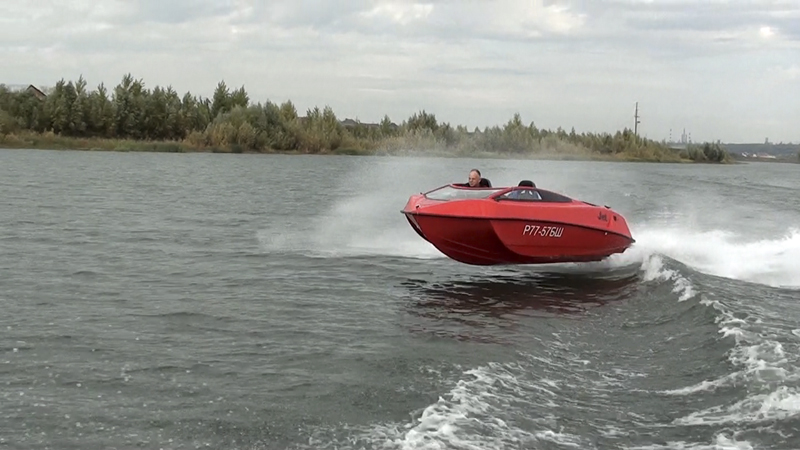

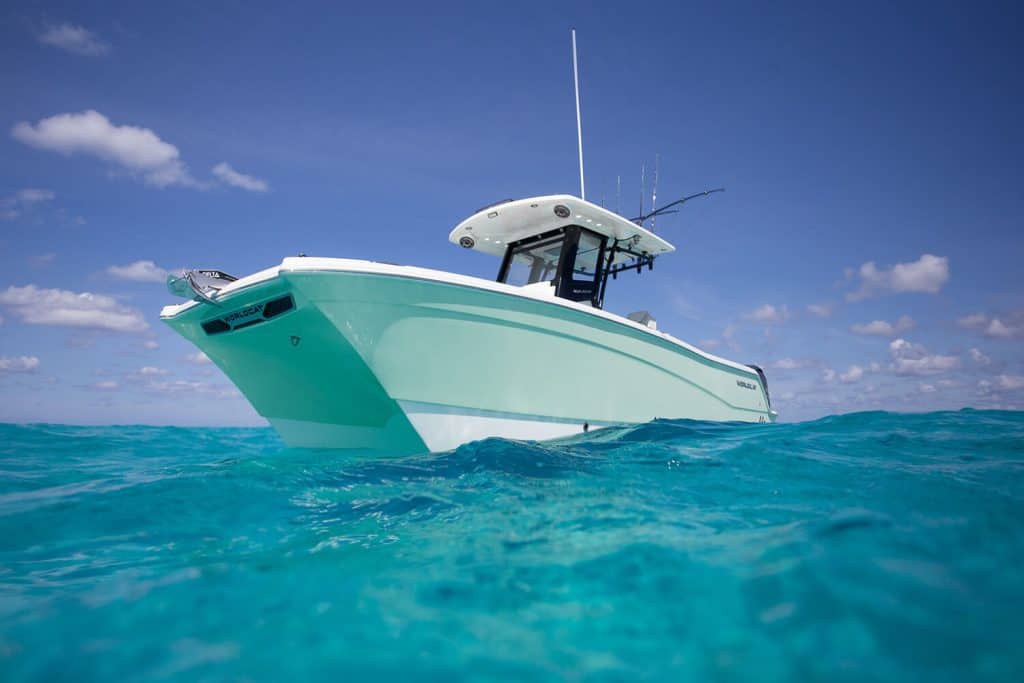
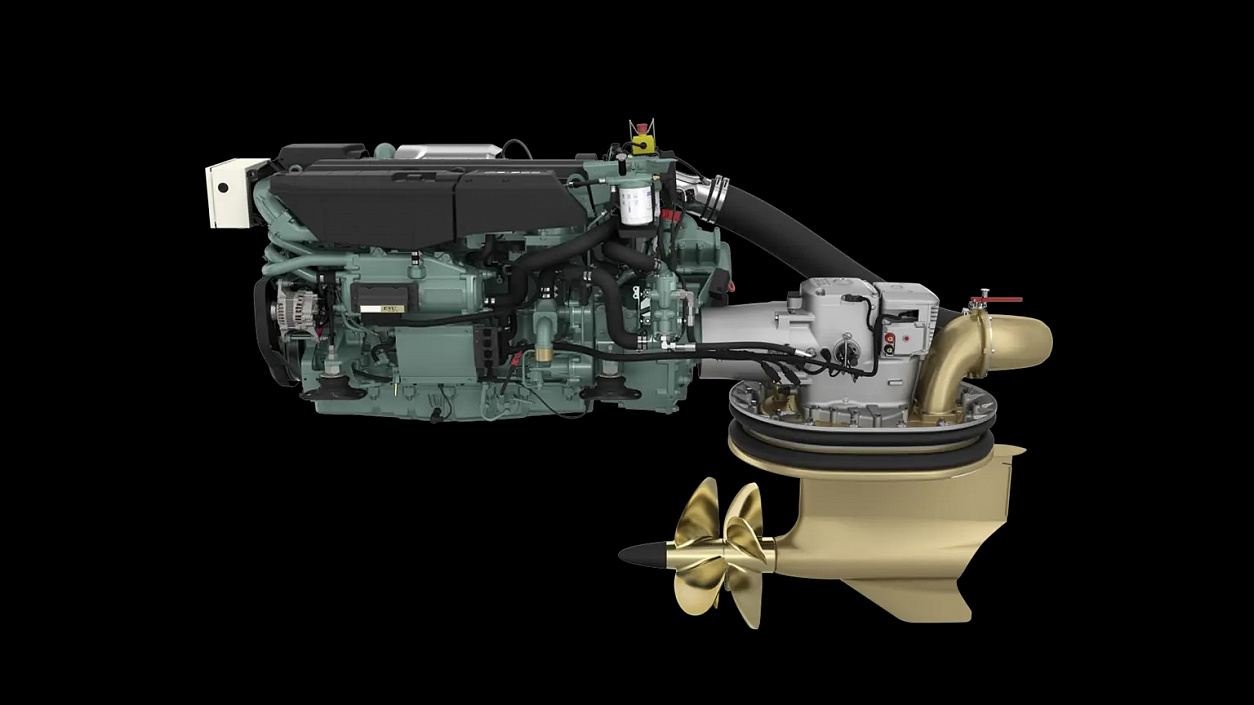

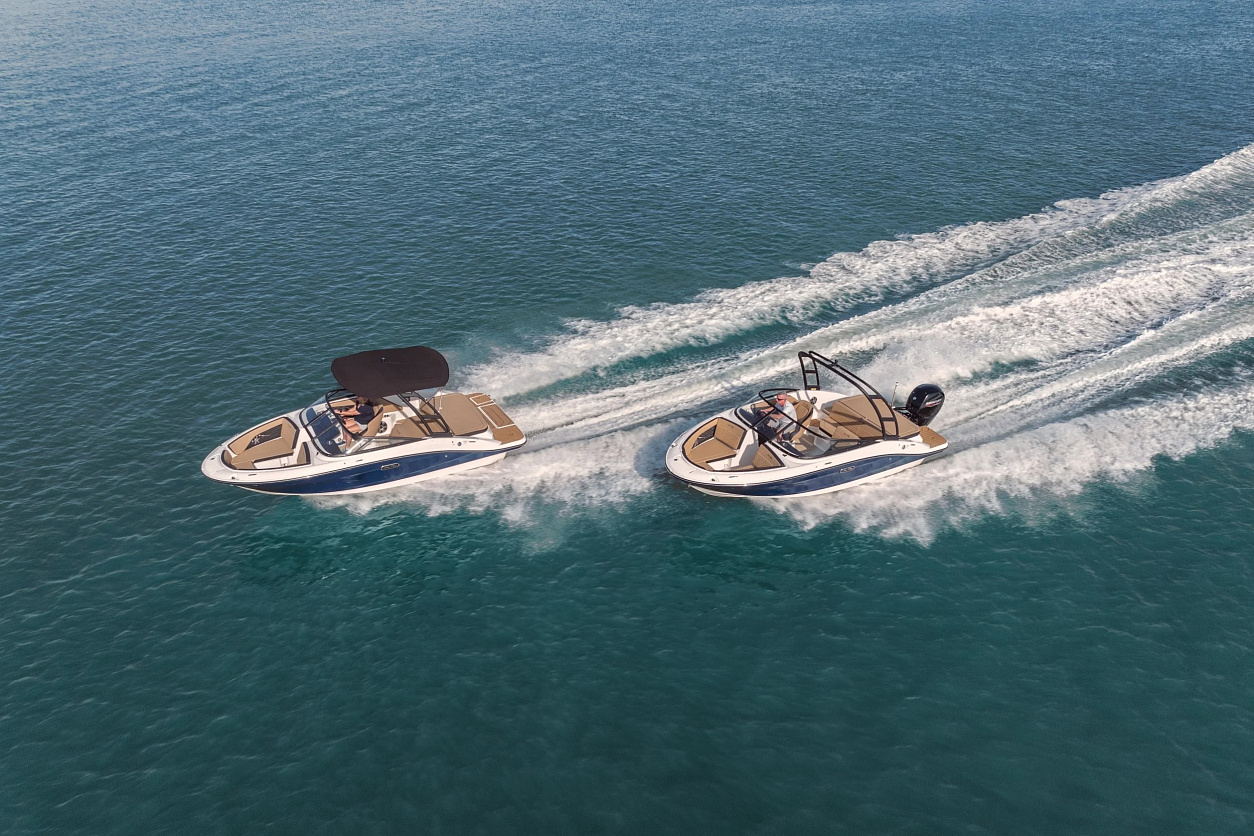
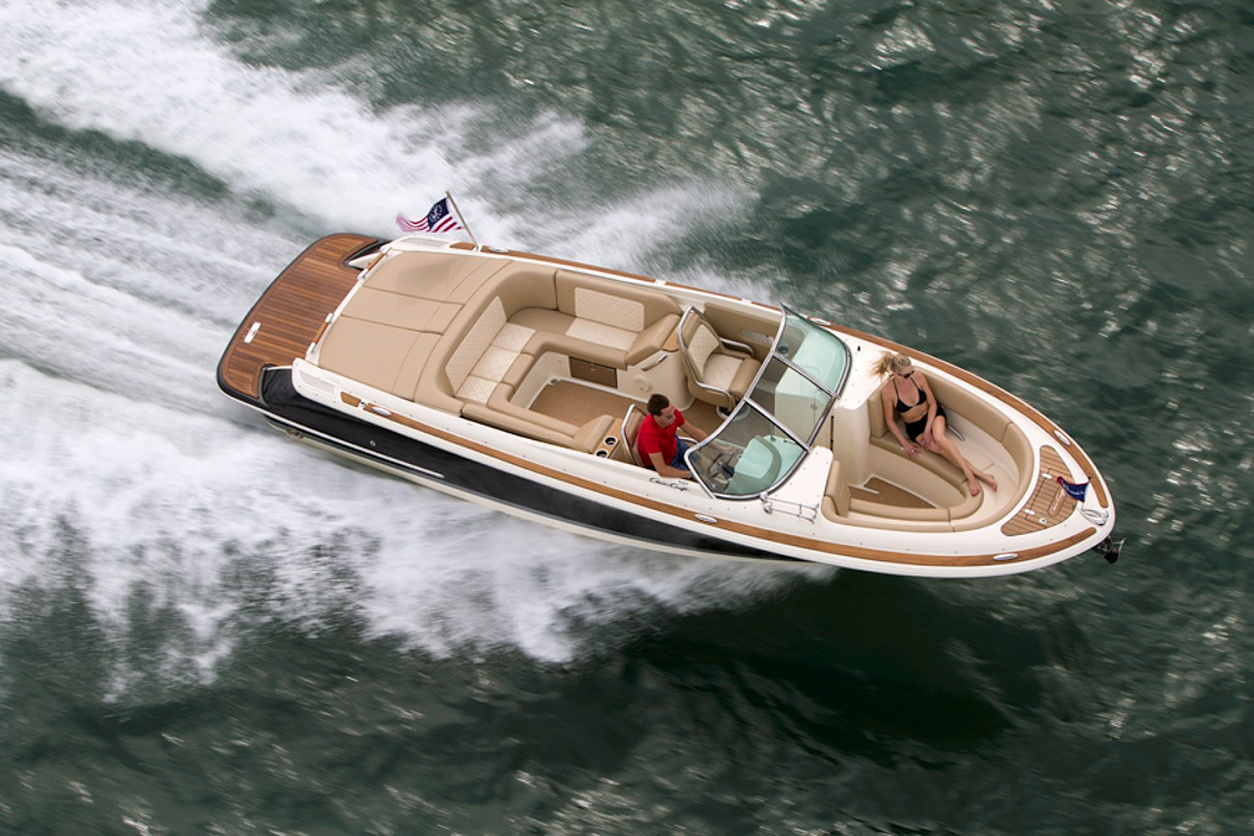
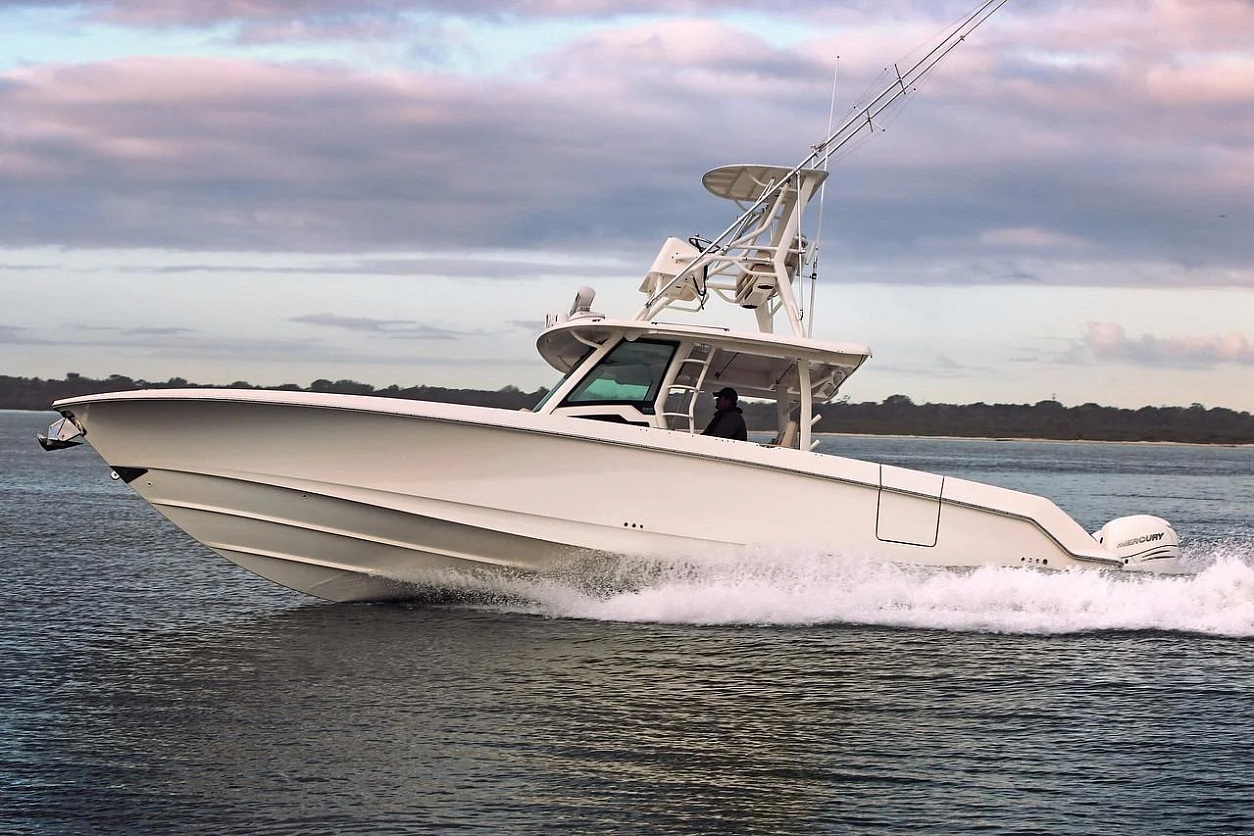
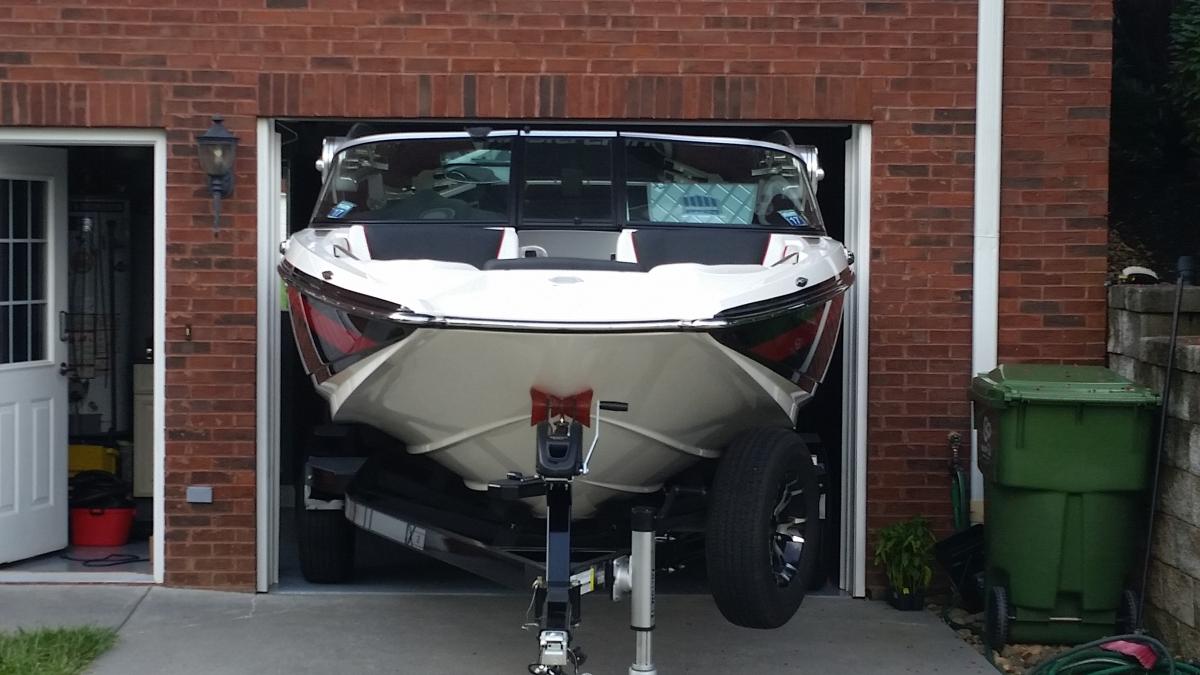
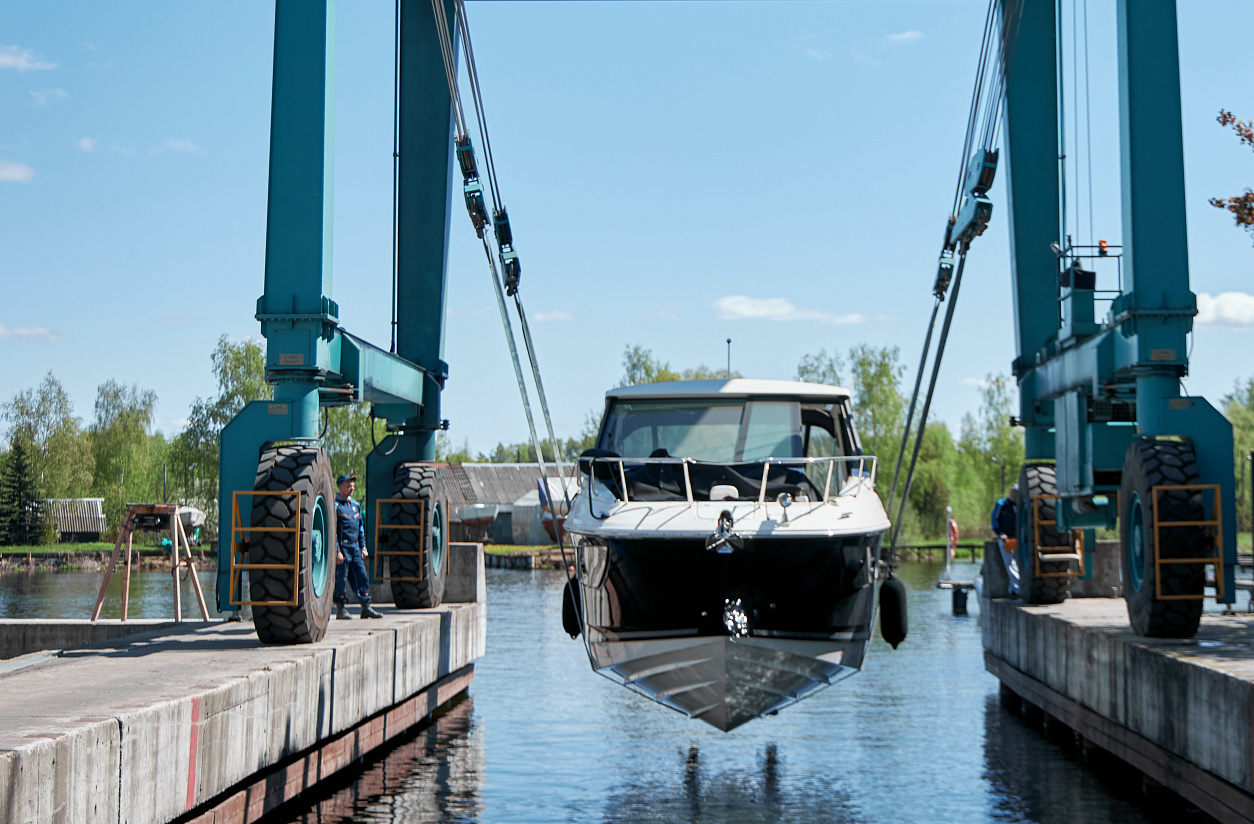
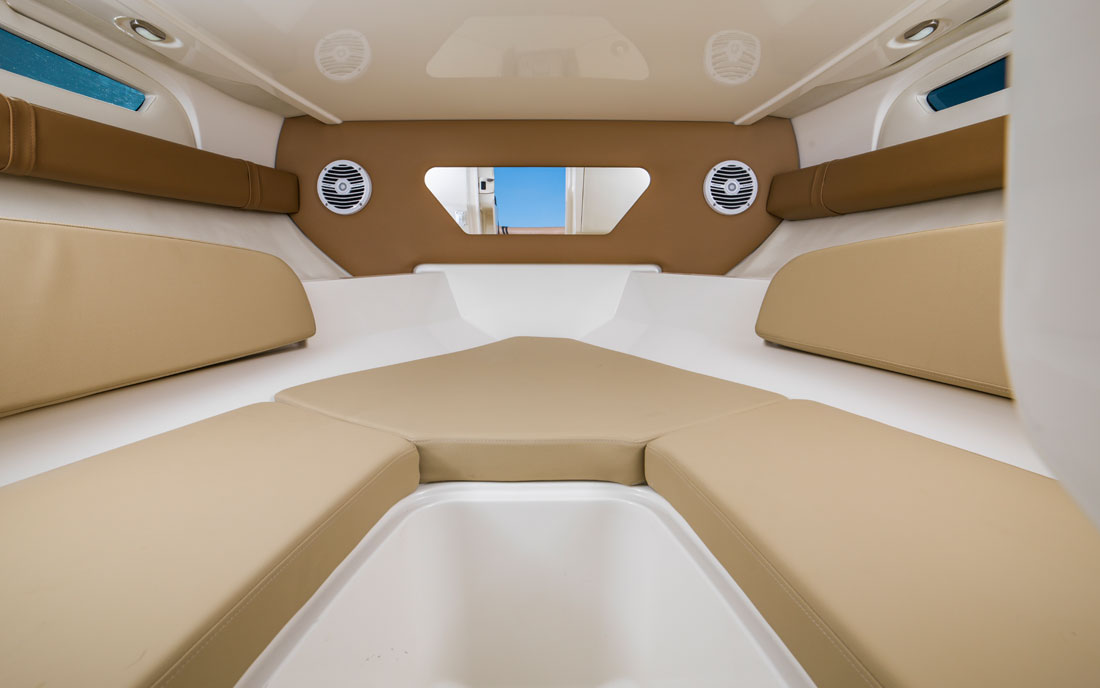
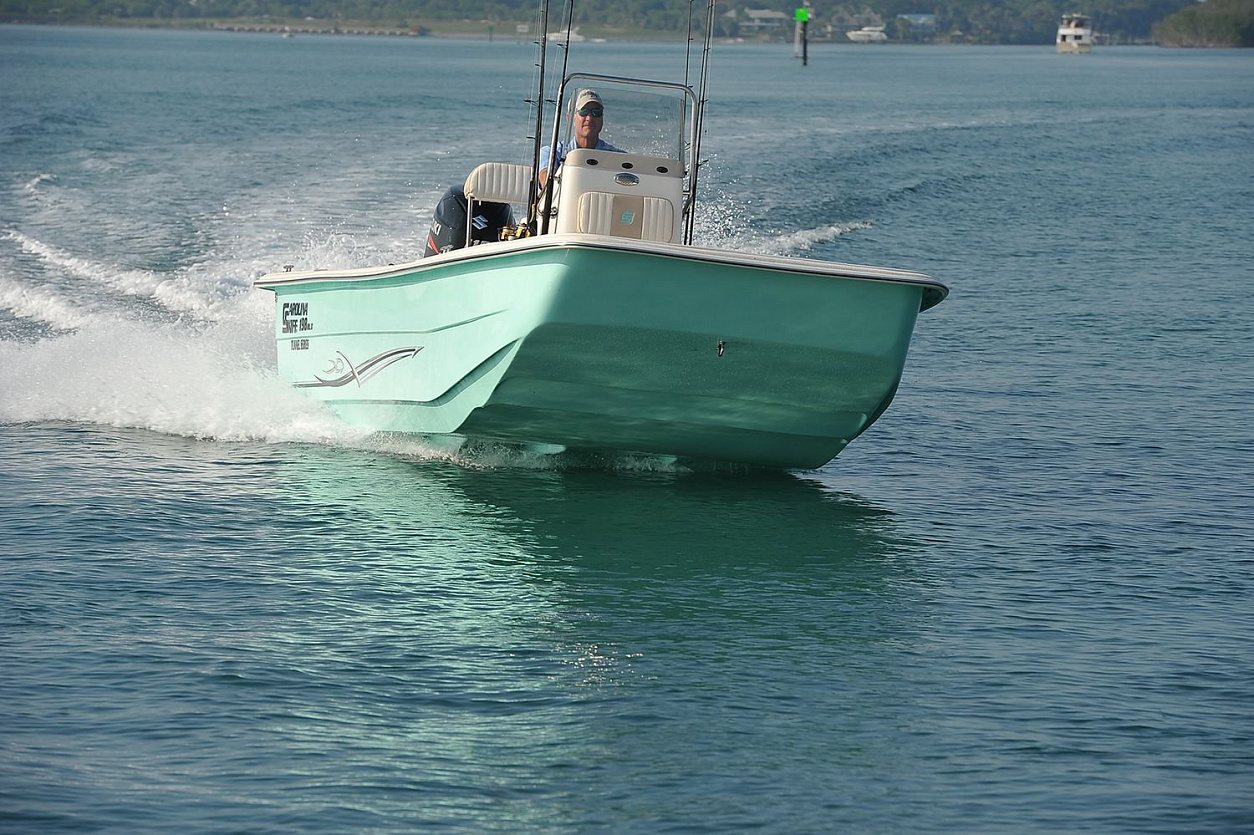
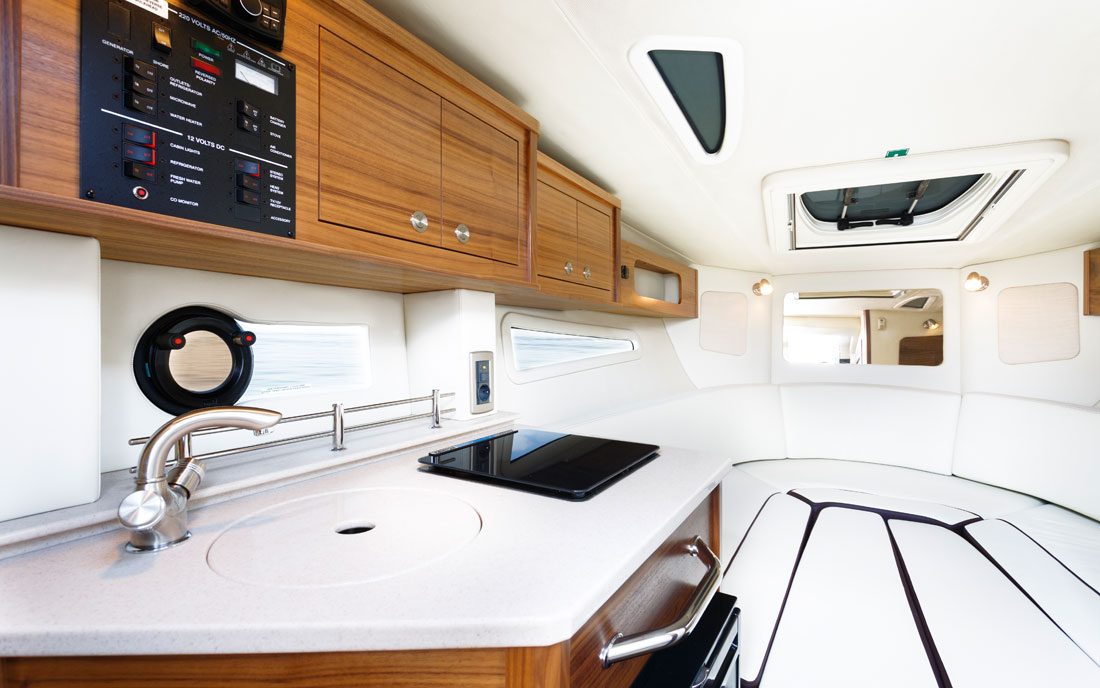

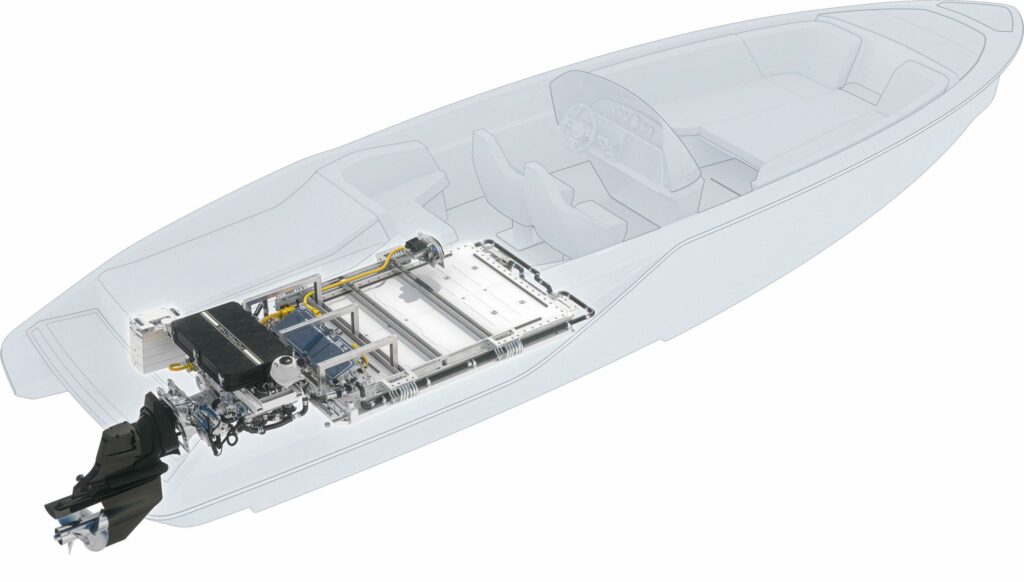

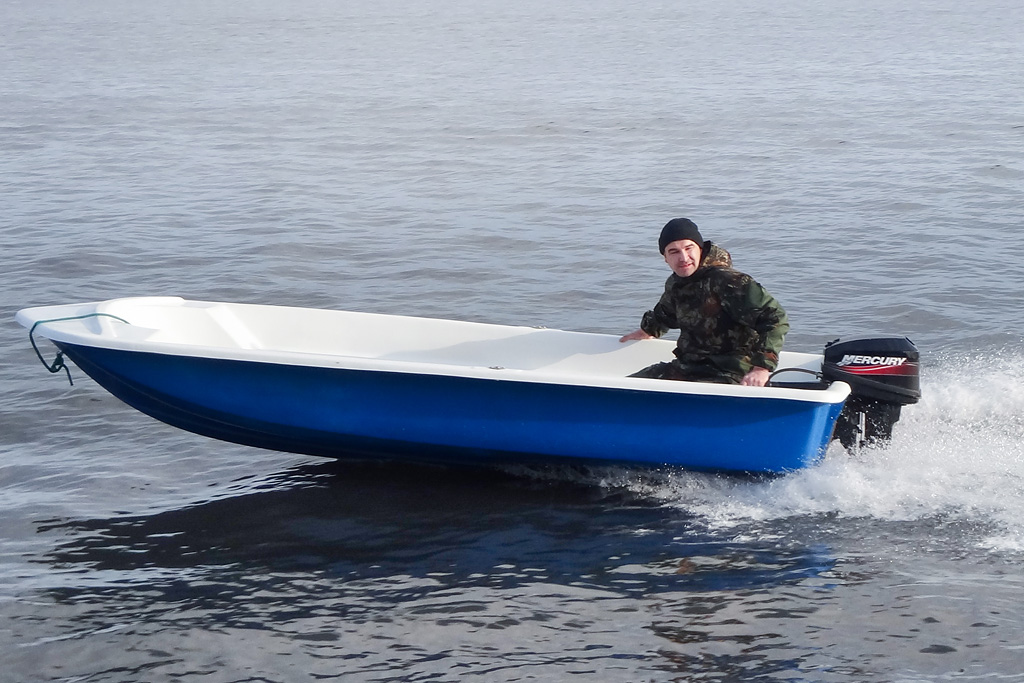
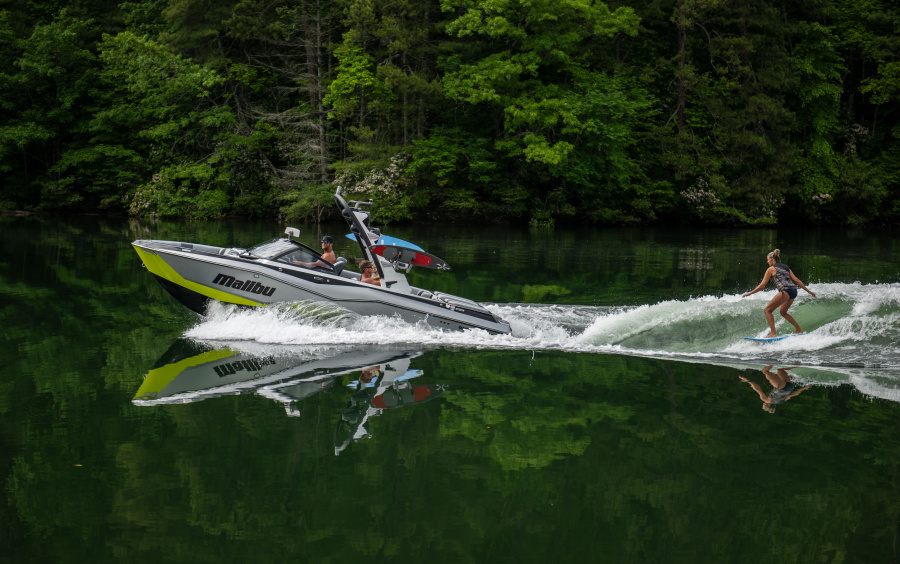
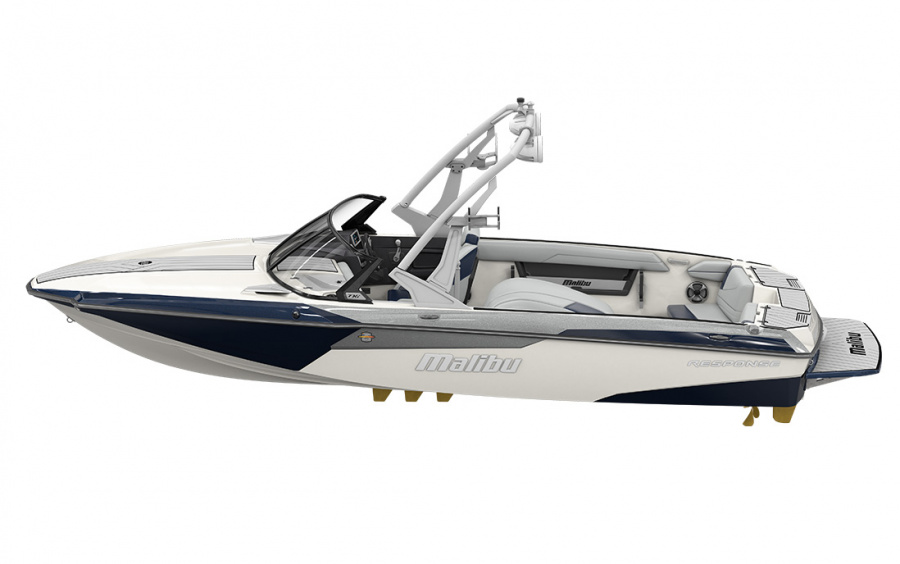
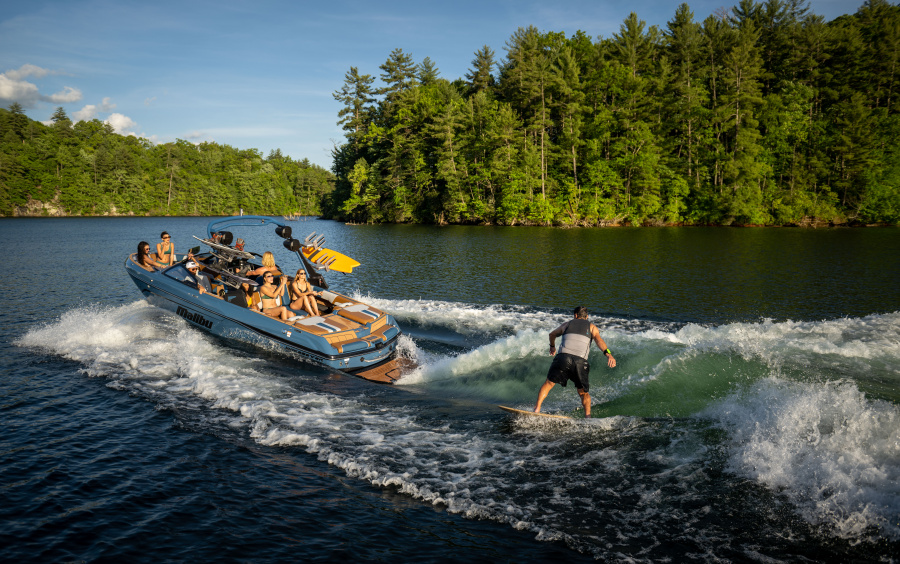
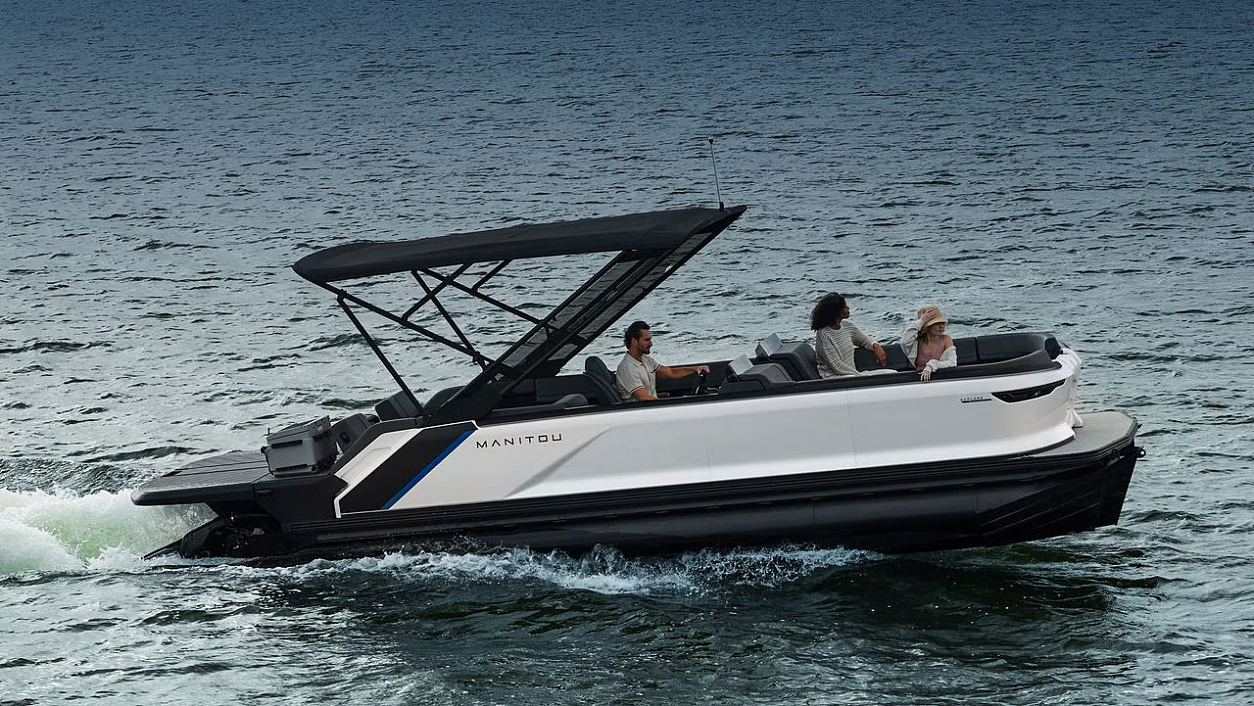
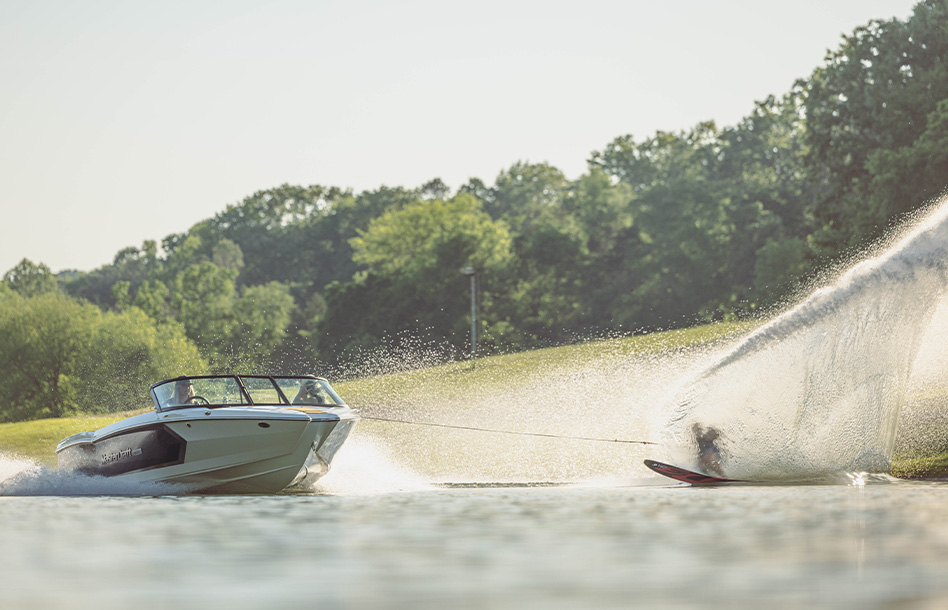

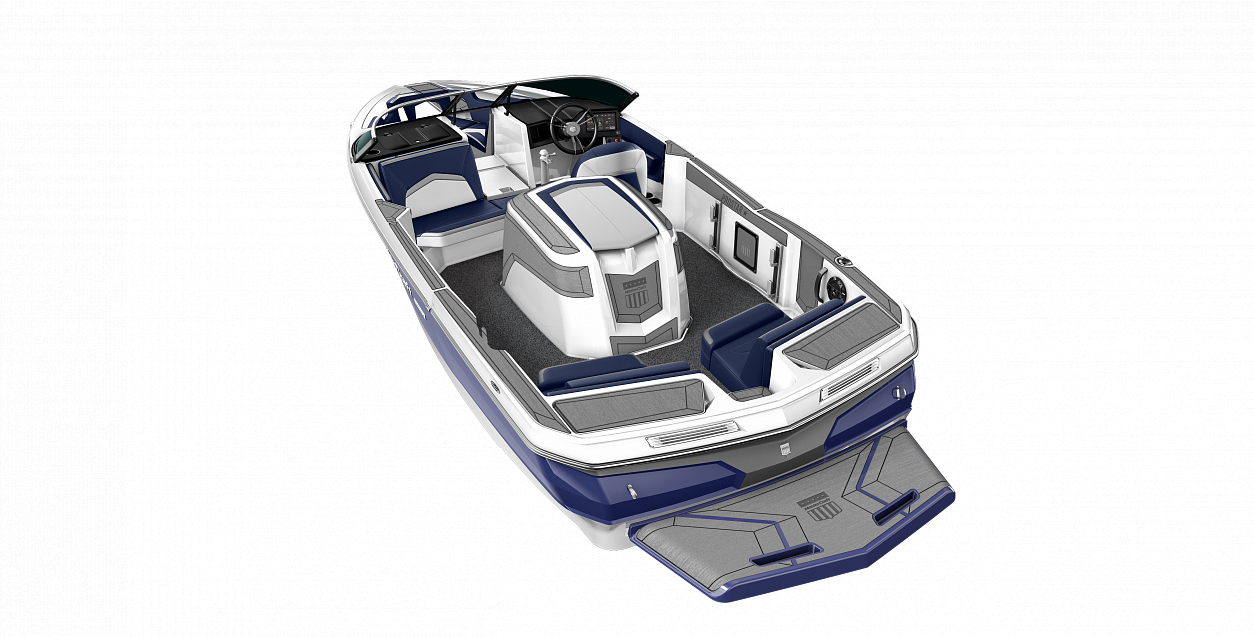
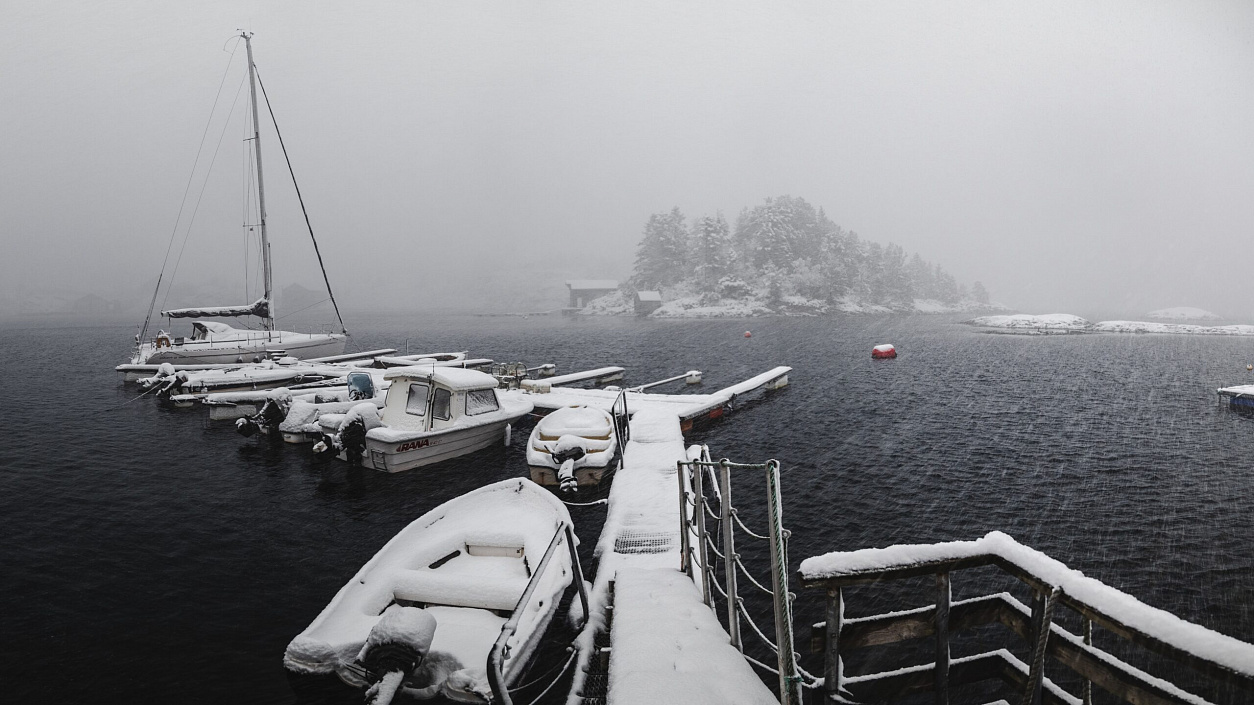


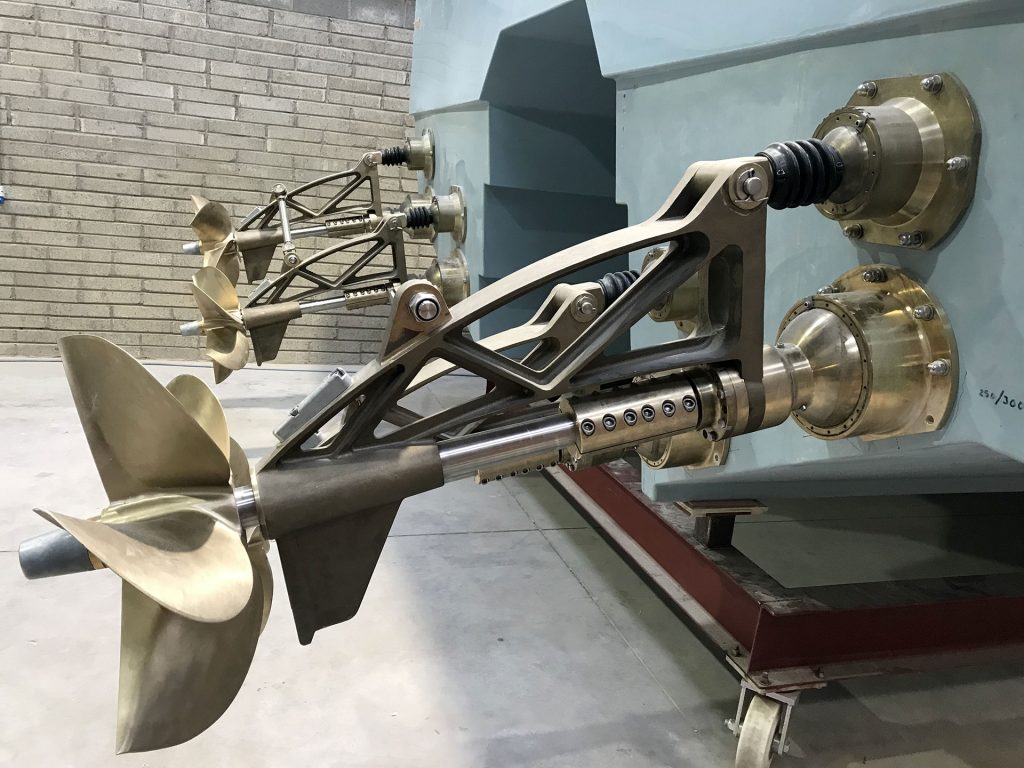
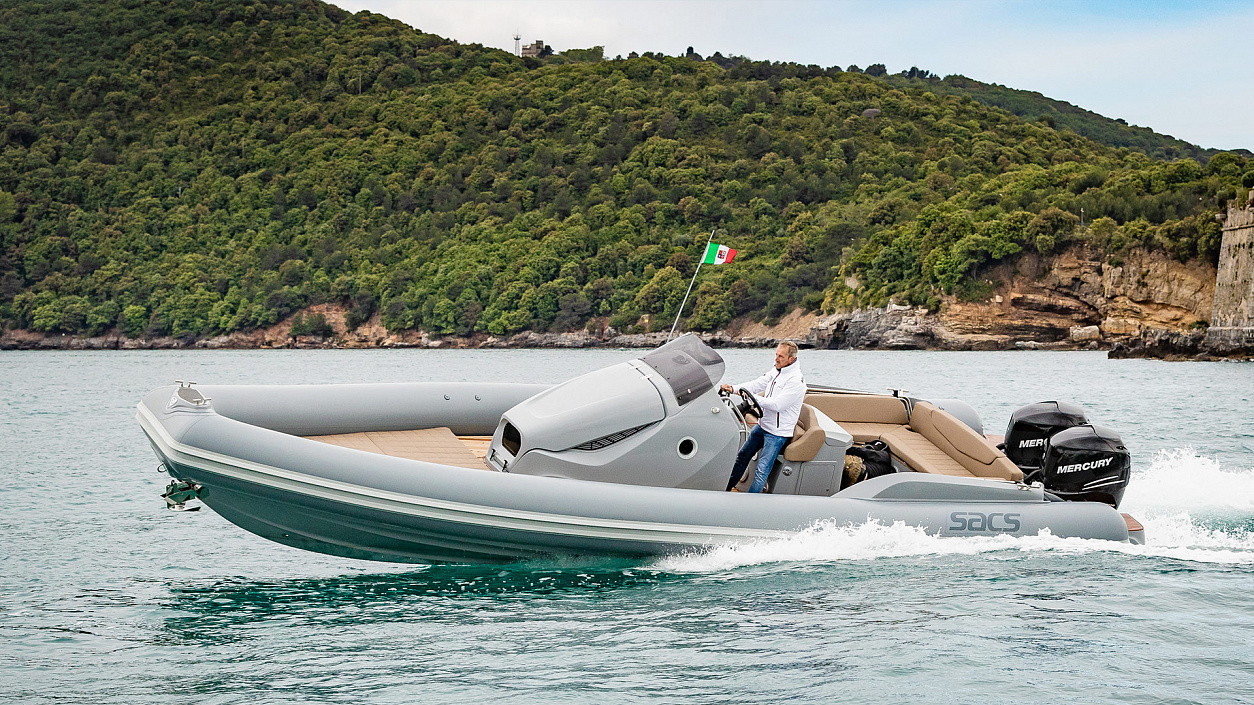
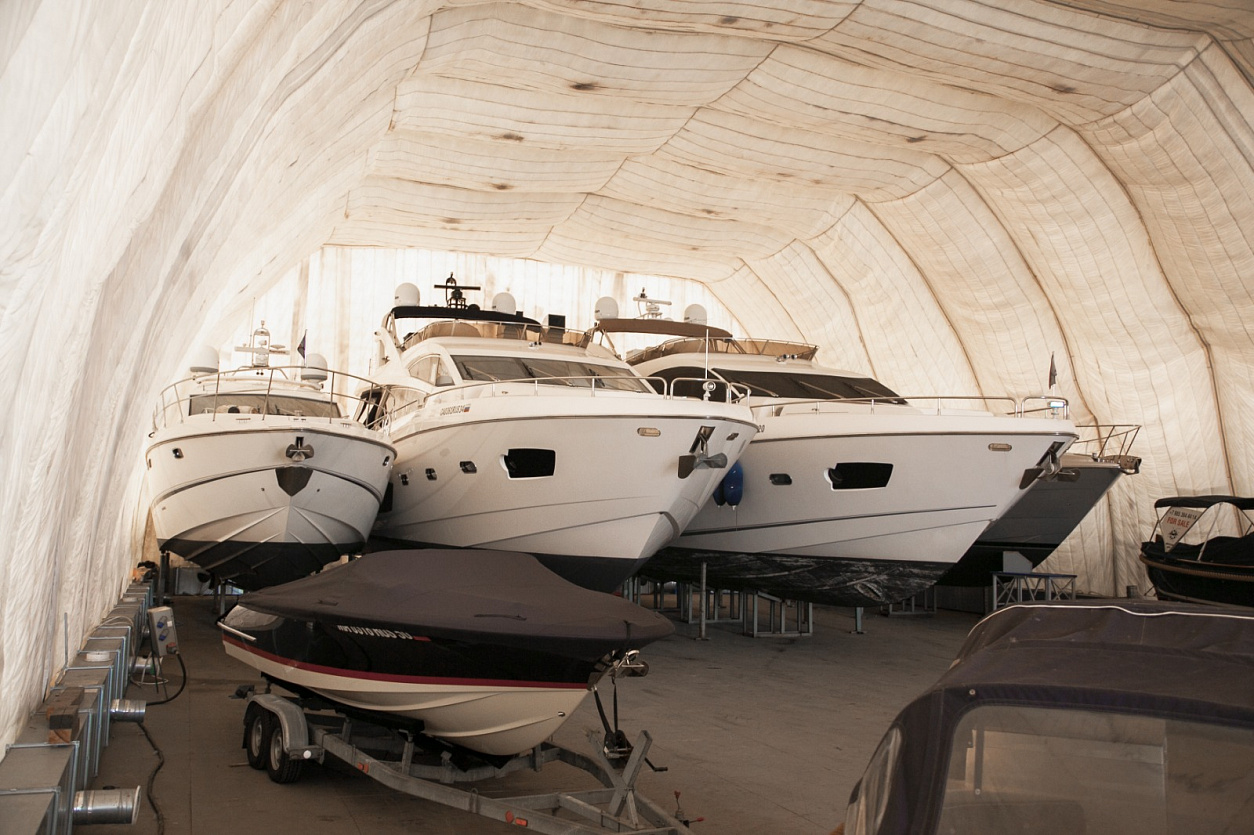

Buying a motor boat: what to know
What is a motor boat
A motorboat is a small motorized vessel equipped with either an inboard or outboard engine, a dedicated helm station with a round steering wheel, passenger seats, windshields or glass panels, and a hull designed for planing.
Frequently Asked Question: How does a motorboat differ from a motorized dinghy?
A dinghy is simpler than a motorboat. Instead of seats with backrests, it may have benches. Its engine is usually outboard, and steering is done using a tiller handle rather than a wheel, meaning the operator sits at the stern near the motor. Additionally, the hull shapes differ: a motorboat's hull is optimized for planing, while a dinghy's hull may be rounded or flat.
 Motorized dinghy
Motorized dinghy
Types of motor boats
Motorboats differ in functionality (design features), hull material and type, as well as the type of propulsion and engines.
Hull Types
Deep Vee Hull
 Deep Vee Hull
Deep Vee Hull
Most motorboats and yachts feature a hull with a V-shaped cross-section, giving this design its name. This type of hull cuts through waves efficiently, maintains excellent course stability, and ensures high maneuverability at speed (the boat leans easily into turns when the wheel is turned). However, the downside is that this type of hull is more prone to rolling in rough waters.
Catamaran (Multi-Hull Boats)
 Catamaran boat
Catamaran boatCatamarans have two separate V-shaped hulls connected by a deck. They are more stable and have a shallower draft compared to traditional single-hull boats. Catamarans are also lighter and require less energy to reach planing speeds, offering a smoother ride in choppy conditions by distributing impacts over a larger surface area. However, their aesthetics may not appeal to everyone, they are less responsive to steering, and their turning radius is larger. Trimaran boats (with three hulls) are less common.
Cathedral hull
Cathedral hulls are rare but still available on the used boat market. These boats feature a central V-shaped hull flanked by two additional sponsons with air channels between them. This design provides easy handling and good stability, but the wide bow area tends to cause slamming in rough waters.
Flat bottomed hull
 Flat-bottom hull boat
Flat-bottom hull boat
Flat-bottom boats offer great stability and a shallower draft compared to most V-shaped hulls and their variations. However, they are highly susceptible to drifting and slamming in rough water, making them unsuitable for sea use.
Pontoon boat

Pontoon boat
Pontoon boats feature a deck platform mounted on two or more aluminum tubes (pontoons), which are tapered at the bow to cut through waves. Pontoon hulls are among the most stable, especially those with three pontoons, but they are limited in rough water conditions. Pontoons can either be hollow or filled with foam to maintain buoyancy in case of damage.
Other specialized hull designs, such as tunnel hulls, hydrofoil-equipped boats, and hybrid V-shaped hulls with tunnels, also exist. However, these are rare on the mass market. Hydrofoil boats are even less common.
Types of Motorboats by Functionality
Runabout (Recreational Motorboat)
 Frauscher 610 San Remo
Frauscher 610 San Remo
Runabouts are small boats without cabins or heads, designed for short trips and water commuting. Their cockpit layout resembles a convertible car, with two front seats and a rear bench. They often feature a sunbathing platform at the stern and can have a retro design. Examples: Riva Iseo, Chris-Craft Capri, Frauscher 610 San Remo.
Bowrider
 Chris-Craft Launch 27
Chris-Craft Launch 27
Bowriders are open motorboats with a separate bow cockpit, ideal for outings with a bunch of friends. Larger models may include a cabin and a head. Examples: Sea Ray 190 SPX, Chris-Craft Launch 28 GT, Cobalt boats.
Cabin cruiser
 Laky Verf 11MM
Laky Verf 11MM
Cabin cruisers feature a fully or partially enclosed cabin separated from the open cockpit, housing the helm station and a small dining/lounge area. These boats are perfect for regions with unpredictable weather or cooler climates. Examples: Laky Verf 11MM, Falcon C7, Bella 620C, Sea Ray 320 Coupe.
Cuddy cabin
 Cuddy cabin на катере Sea Ray 230 Sunsport
Cuddy cabin на катере Sea Ray 230 Sunsport
Cuddy cabin boats have a small sleeping area in the bow with minimal amenities. The cabin typically includes a triangular sleeping berth with storage underneath, often housing a compact portable toilet. Example: Sea Ray 230 Sunsport.
Cruiser
 Cabin with a small galley on Sea Ray 265 Sundancer
Cabin with a small galley on Sea Ray 265 Sundancer
Cruisers are more comfortable than cuddy cabin boats, offering a more spacious cabin where one can stand upright in some models. They usually feature a built-in restroom with a shower and sink, foldable tables, shelves and cabinets, and a small galley. Example: Sea Ray 265 Sundancer.
Fishing boat (sport fisher)
 Boston Whaler 380 Outrage
Boston Whaler 380 Outrage
Fishing boats, such as the Boston Whaler Outrage, are designed for professional fishing. They are equipped with live bait compartments and mounts for fishing gear. These boats often feature a center-console layout, with the helm station located on an island in the middle of the cockpit, allowing easy movement around the boat. High-end models for deep-sea fishing may include a tower above the main cabin with an additional helm station.
Ski boat

Mastercraft ProStar
Water ski boats, like the Mastercraft ProStar, are powerful vessels equipped with a towing pylon for pulling water skiers. The engine is typically mid-mounted for better weight distribution and to minimize wake. Modern models include cruise control systems to maintain a consistent towing speed, avoiding jerks or slack in the towline.
Wake boat
 Malibu 22 LSV
Malibu 22 LSV
Wake boats, such as the Malibu 22 LSV, are designed to create specific wave shapes for wakeboarding or wakesurfing. They feature adjustable trim tabs and ballast tanks to increase displacement and enhance the wave size. These boats are also equipped with towers for attaching towlines, board racks, and speakers.
Motor yacht
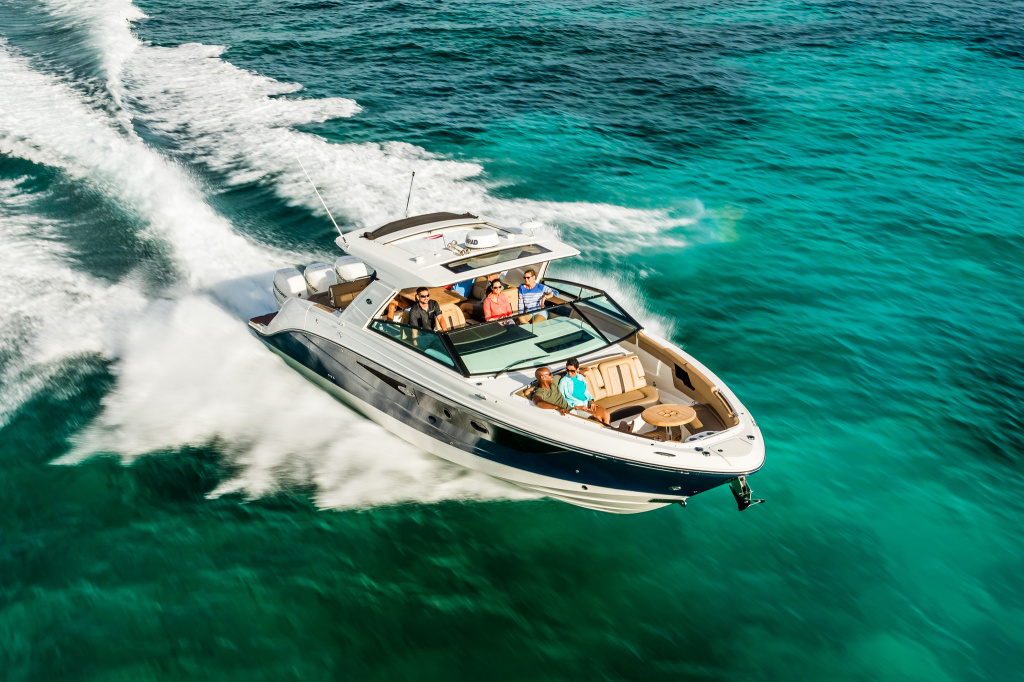
This category includes boats over 40 feet long with multiple cabins, separate restrooms, a galley, and freshwater storage, allowing for extended stays on board. Example: Sea Ray SLX 400.
RIB
 SACS Strider 10
SACS Strider 10RIBs, or rigid inflatable boats, combine a hard deep-V hull with inflatable side tubes for protection. Originally designed for rescue teams, military, and police use, they are now popular as tenders for superyachts or standalone recreational boats for weekend trips. Example: SACS Strider 10.
Motorization
Motorboats can be equipped with either inboard or outboard engines. Inboard engines are installed inside the hull (in the engine compartment) of the boat. Most motorboats typically will have one or two inboard motors. Outboard engines, on the other hand, are mounted externally on the transom. These can range from one to 3–4 engines. Both inboard and outboard motors can run on gasoline, diesel, or electricity. Hybrid models are also available.
Inboard engines
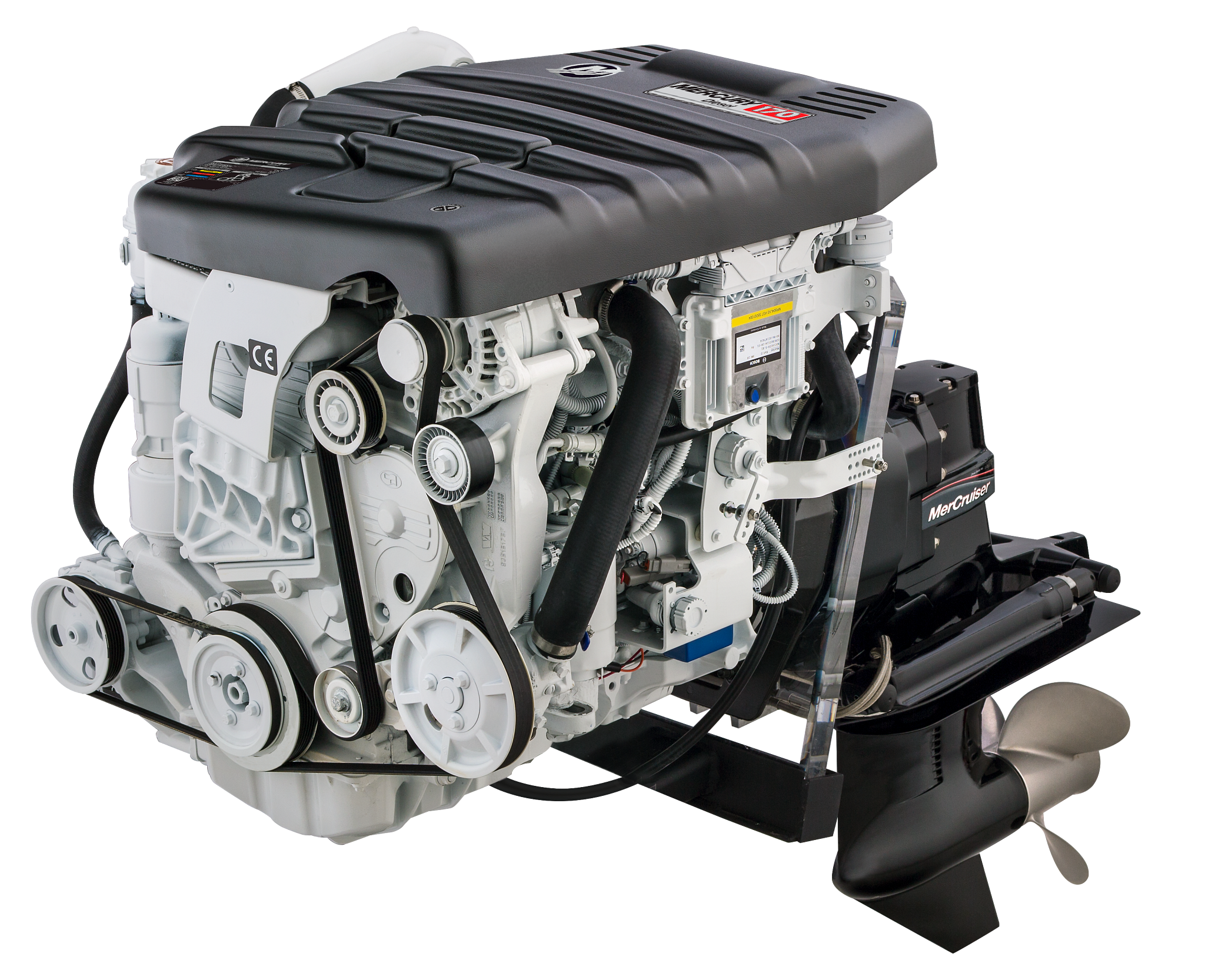
Mercury Diesel 2.0L inboard engine coupled to a stern-drive
Advantages of Inboard Engines:
- Do not disrupt the boat's exterior design.
- Keep the stern uncluttered.
- Provide a lower center of gravity, improving stability.
- Operate more quietly compared to outboard motors.
- Are protected from damage and environmental factors.
- Safer for families with children on board.
- Deliver higher specific power output.
- Compatible with various types of propulsion systems.
- Difficult to steal compared to outboard motors.
Disadvantages of Inboard Engines:
- Less convenient for repairs compared to outboards.
- Occupy significant space within the hull.
- Boats with inboard engines typically have smaller fuel reserves than those with outboards.
- Replacing the engine with one of different specifications can be challenging.
- Require winterization for off-season storage (though outboard engines also require this, they can be stored separately, making the process easier).

Outboard motor on a boat
Outboard Engines
Advantages of an outboard engine:
- Easy to transport and store.
- Simple to remove for repairs or replacement.
- Can be tilted up when approaching shallow or unprepared shores to reduce draft and protect the propeller.
- Do not take up space inside the boat.
- Typically allow for larger fuel reserves on the boat.
- More efficient due to their lighter weight and placement closer to the stern.
- When selling, the boat can be sold separately from the motor, which may be advantageous in some cases.
- Louder than inboard engines, which are enclosed in an engine compartment.
- Can make it difficult or impossible to use the swim platform.
- Require extra attention if children are on board.
- At risk of theft if the boat is left unattended for long periods.
- Not suitable for wakesurfing or wakeboarding.

Inboard electric propulsion system of a Frauscher x Porsche 850 Phantom
For the same boat equipped with either an outboard motor or an inboard engine with a standard stern drive (Z-drive), the outboard motor is generally more efficient. For example, a 200-hp outboard motor can deliver the same performance as a 250-hp inboard engine. This is due to the outboard's lighter weight and its placement, which is closer to the stern and more efficient. As a result, boats with outboard motors often consume less fuel.
Propulsion
In addition to engines, boats differ in their propulsion systems, which convert the engine's torque into forward motion. Each type has its own advantages and disadvantages.
Shaft Drive (Including V-Drive)
This is the classic propulsion system. The engine drives a shaft via a gearbox, with a propeller at the end of the shaft. A V-drive is a variation where the engine’s output shaft faces forward and connects to the propeller shaft in a V-shaped configuration. This allows the engine to be positioned closer to the stern, freeing up space inside the hull.
Advantages:
- Simple, reliable, and durable.
- Provides a low center of gravity and optimal weight distribution.
- If the propeller strikes the bottom or an underwater object, the hull and engine are less likely to be damaged.
- Limited maneuverability compared to other systems.
- Not compatible with joystick controls.
- If the rudder fails, controlling the boat becomes nearly impossible with a single engine.
Pod-drive

The engine is mounted inside the hull, while the propulsion system consists of a rotating pod with propellers, attached to the boat's bottom.
Advantages:
- Pods can rotate independently, providing exceptional maneuverability and ease of control (especially with joysticks).
- Forward-facing propellers operate in clean, non-turbulent water, improving efficiency.
- Saves space inside the hull since much of the system is external.
.Disadvantages:
- Expensive to purchase and repair.
- Repairs can be complex and costly.
- The hull may be damaged if the pod strikes an underwater object or the bottom.
Stern-drive (Z-drive)
This is one of the most common propulsion systems. Essentially, it combines the lower unit of an outboard motor with an inboard engine. It can also be paired with joystick controls for easier handling. Some variants, like the Mercury Bravo Four S Forward Drive, feature forward-facing propellers, making them suitable for water sports like wakeboarding and wakesurfing.
Advantages:
- Highly maneuverable and easy to control.
- The drive can tilt in different directions, allowing for precise trim adjustments.
Disadvantages:
- Requires skilled maintenance.
- Poor maintenance can lead to leaks in the hull.
- Single-propeller stern drives can cause course instability, requiring constant corrections.
Waterjet (Jet-drive)
Jet drives are ideal for shallow waters. They work by drawing water into a pump and expelling it at high pressure to propel the boat.

Advantages:
- Minimal protruding parts, reducing the risk of grounding or hitting rocks.
- Easily switches to reverse mode, allowing for quick stops.
Disadvantages:
- Less fuel-efficient than other propulsion types.
- Slower to reach planing speeds.
- Can be noisy.
- Significant power losses during thrust conversion make jet boats less efficient and slower at mid-range speeds.
Surface drive

Surface drives are designed for maximum speed. They minimize hydrodynamic drag by eliminating elements like rudders, cavitation plates, and gear housings. The partially submerged propeller itself is more efficient.
Advantages:
- Higher speeds.
- Reduced draft compared to other systems.
Disadvantages:
- Larger turning radius.
- Propellers can be hazardous to swimmers.
- Increased noise levels.
How to choose a boat?
The first step in buying a boat is determining your budget. This is usually the first question sales managers ask potential buyers. If you’re a first-time buyer, it’s important to understand that your budget should include not only the cost of the boat but also its maintenance expenses. These depend on the size of the boat, the manufacturer (domestic or foreign), usage intensity, registration fees, and transportation to its base location.

Why Pay More for a Branded Boat?
The difference between a cheap boat and a high-quality branded one becomes apparent quickly.
Potential disappointments with cheap boats:
- Performance: Poorly designed boats may not handle well, bounce on waves, struggle to maintain course, or fail to plane efficiently.
- Comfort: Low-quality boats often lack storage space, have poor ergonomics and inconvenient controls. Cabins may have sharp edges or undersized amenities.
- Component Quality: Cheap materials can lead to rusting metals, cracking vinyl, yellowing fiberglass, or malfunctioning fixtures.
- Hull Quality: Thin or poorly constructed hulls can cause noise, vibrations, and an overall unpleasant experience on the water.
- Gelcoat: Low-quality gelcoat can quickly develop cracks, fade, or absorb water, leading to structural issues.
Purpose and Use
Once your budget is set, consider how and where you’ll use the boat. This determines the size, power, and features you need.
Questions to ask yourself:
- Where will you use the boat? River, lake, or sea?
- How long will you stay on the water? Do you need a restroom, freshwater supply, galley, or cabin?
- Who will be onboard? Alone, with a partner, or in a group? Will there be children?
- What type of activities do you enjoy? Fishing, weekend trips, long cruises, beach outings, or water sports?
- Where will you store the boat during the off-season?
- Is there nearby infrastructure for repairs and maintenance?
Winter storage of a boat

Outdoor
Many owners of budget boats store them outdoors or under a canopy. Typically, the boat is left in the yard of a country house or a parking space is rented. However, storing a boat outside during the winter is not the best option. Even a specialized cover cannot protect it from drastic temperature fluctuations and high humidity. Seasonal changes in temperature and precipitation can lead to condensation and corrosion on the boat. If the boat is kept at a cottage, there is a risk that small rodents may find their way inside in search of shelter, damaging the wiring and upholstery. In urban outdoor parking, the boat may suffer from corrosion due to salt solutions and chemicals used on the roads.
Garage

Dry-dock storage

Storing a boat in a covered hangar (or marina) is the optimal choice. It offers convenient slip access, security, maintenance, and repairs—all in one place. In these hangars, the temperature and humidity are kept at ideal levels for winter storage, ensuring that boats remain in perfect condition. You won't have to worry about the safety of your boat. Before winter storage, you can arrange for professional preservation, and during the winter, you can carry out any necessary repairs or upgrades with additional equipment.
However, there are some drawbacks: the cost can be quite high, and there is a limited number of spots available during the season (you need to book in advance to secure a place). Additionally, if you are one of the first to store your boat and it gets placed at the far end of the hangar, you may have to wait for other boats to be removed before you can access yours at the beginning of the season..
Preparation for winter storage
Addressing the winter storage of a fiberglass boat is best done before the first frost. The ideal place for storing the boat during the cold season is a heated hangar. However, before placing the boat inside, it must be properly preserved.
First, drain all used fluids and flush the engine's cooling system with clean water. The cylinder block should be flushed with antifreeze to prevent corrosion and protect the engine from freezing water. It's advisable to replace the filters and oil in both the engine and the gearbox, lubricate the propellers, steering mechanisms, and linkages, check the condition of the seals, and clean the drive components from debris and deposits.
It's best to store the boat with the fuel tank filled to 95% to prevent the formation of resinous deposits and condensation. A fuel stabilizer should be added during this process. The boat's hydraulic systems should be filled with a preservative solution of propylene glycol, with the concentration depending on the temperature at which the boat will be stored.
Transporting a boat

Transporting a boat to its destination or winter storage is not always possible by water. Therefore, sooner or later, almost every boat owner faces the need to transport their vessel. Depending on its size, a boat can be transported on a special trailer towed by a vehicle or on a flatbed truck.
Requirements for Transporting Boats in Europe
In Europe, the regulations for transporting boats vary by country, but generally, the following dimensions apply for standard transport without special permits:
- Length: No more than 12 meters (39.37 feet) for road transport; larger boats may require permits.
- Height: No more than 4 meters (13.12 feet).
- Width: No more than 2.55 meters (8.37 feet).
- Weight: Up to 3.5 tons (7,700 lbs) for standard trailers; heavier loads require a truck and special permits.
If any dimension exceeds these limits, the vessel is classified as oversized cargo, which necessitates a warning sign, a transport permit, and possibly escort vehicles. Additionally, loading and unloading must be done carefully to avoid damage, and hiring a company experienced in boat transport is highly recommended to ensure safety and compliance with local laws.
Requirements for Transporting Boats in the USA
In the United States, the rules for transporting boats also vary by state, but the following general guidelines apply:
- Length: No more than 26 meters (85 feet) for road transport; boats over this length typically require special permits.
- Height: Maximum height is generally 4.3 meters (14 feet).
- Width: Standard maximum width is 2.59 meters (8.5 feet).
- Weight: The weight limit for standard trailers is typically 3,500 kg (7,700 lbs); heavier boats may need a flatbed truck and special permits.
Transporting oversized boats requires a permit from the state Department of Transportation, and often necessitates a special escort vehicle. Proper rigging and loading techniques are crucial to prevent damage during transport, so it’s advisable to use a specialized transport company that understands the nuances of boat transportation.
Transporting a boat involves adhering to specific regulations regarding size, weight, and safety. It's crucial to be aware of these rules and to work with experienced professionals to ensure a smooth and safe transportation process.
It's certainly a challenge to address all the questions that may arise for someone considering purchasing a boat in a single article. Feel free to send us your question, and we will promptly provide you with detailed responses from our experts on boats and yachts.Join us in Telegram












